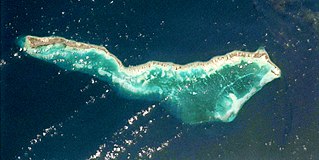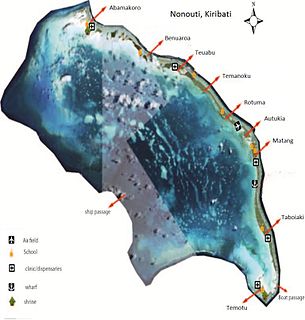
Kiribati, officially the Republic of Kiribati, is an independent island nation in the central Pacific Ocean. The permanent population is just over 110,000 (2015), more than half of whom live on Tarawa atoll. The state comprises 32 atolls and one raised coral island, Banaba. They have a total land area of 811 square kilometres and are dispersed over 3.5 million km2 (1.4 million sq mi).

Moroni is the largest city, federal capital and seat of the government of the Union of the Comoros, a sovereign archipelago nation in the Indian Ocean. Moroni means "at the river". Moroni is the capital of the semi-autonomous island of Ngazidja, the largest of the three main islands of the republic. The city's estimated population in 2003 was 41,557 residents. Moroni, which lies along the Route Nationale 1, has a port and several mosques such as the Badjanani Mosque.

Tabuaeran, known in English as Fanning Island, is an atoll that is part of the Line Islands of the central Pacific Ocean and part of Kiribati. The land area is 33.73 square kilometres, and the population in 2015 was 2,315. The maximum elevation is about 3 m (10 ft) above high tide.

Abaiang, also known as Apaiang, Apia, and in the past, Charlotte Island, in the Northern Gilbert Islands, is a coral atoll of Kiribati, located in the west-central Pacific Ocean. Abaiang was the home of the first missionary to arrive in Kiribati, Hiram Bingham II. Abaiang has a population of 5,502.

Tabiteuea is an atoll in the Gilbert Islands, Kiribati, farther south of Tarawa. This atoll is the bigger and the most populated of the Gilbert Islands but Tarawa. The atoll consists of one main island, Aanikai in the north, and several smaller islets in between along the eastern rim of the atoll. The atoll has a total land area of 38 km2 (15 sq mi), while the lagoon measures 365 km2 (141 sq mi). The population numbered 5,261 in 2015. The islanders have customary fishing practices related to the lagoon and the open ocean.

Bairiki is a settlement in South Tarawa of Kiribati. The State House, the National Stadium, the High Commissions of Australia and New Zealand as well as the embassy of China, and most of the Government Ministries are based in Bairiki. Bairiki is administered by the Teinainano Urban Council or TUC. As at the 2010 Census the population of Bairiki was 3,524.

South Tarawa is the capital and hub of the Republic of Kiribati and home to more than half of Kiribati's population. The South Tarawa population centre consists of all the small islets from Betio in the west to Bonriki and Tanaea in the north-east, connected by the South Tarawa main road, with a population of 56,388 as of 2015.

Abemama (Apamama) is an atoll, one of the Gilberts group in Kiribati, and is located 152 kilometres southeast of Tarawa and just north of the Equator. Abemama has an area of 27.37 square kilometres and a population of 3,299 as of 2015. The islets surround a deep lagoon. The eastern part of the atoll of Abemama is linked together by causeways making automobile traffic possible between the different islets. The outlying islands of Abatiku and Biike are situated on the southwestern side of the atoll.

Nonouti is an atoll and district of Kiribati. The atoll is located in the South Gilbert Islands, 38 km north of Tabiteuea, and 250 km south of Tarawa. The atoll is the third largest in the Gilbert Islands and is the island where the Catholic religion was first established in Kiribati, in 1888.
Utiroa is a settlement in Kiribati. It is located on Tabiteuea atoll; Nuribenua is to its west, while Terikiai and Eita are to its north.
Terikiai is a settlement in Kiribati. It is located on an atoll; to its west are Nuribenua, Tanaiang, and Te Kapuipui, and to its east are Eita and Utiroa.
According to 2010 government statistics, Christian groups form about 96% of the Kiribati population by census counts, most of whom are either Catholic or members of the Kiribati Uniting Church. Persons with no religious affiliation account for about 0.05% of the population. Members of the Catholic Church are concentrated in the northern islands, while Protestants are the majority in the southern islands.
Waitea Abiuta was one of the first converts to The Church of Jesus Christ of Latter-day Saints in Kiribati and was the first i-Kiribati leader in the LDS Church.
Education in Kiribati is free and compulsory from age 6 to 14, which includes primary school through grade six, and Junior Secondary School for three additional grade levels. In 1998, the gross primary enrollment rate was 84.4 percent, and net primary enrollment rate was 70.7 percent. School quality and access to education are better in urban areas; schools in small communities on isolated islands are expensive to maintain. Mission schools are slowly being absorbed into the government primary school system.
The High Commissioner of the United Kingdom to Fiji is the United Kingdom's foremost diplomatic representative in the Republic of Fiji.

Kauma Adventist High School is a coeducational Christian secondary school located on the island of Abemama, Kiribati, established in 1957. It is a boarding school operated by the Seventh-day Adventist Church. The Adventist mission headquarters for Kiribati, formerly the Gilbert Islands, have been located on Abemama since the late 1940s. An elementary school began there in 1955 shortly after the organizing of the first congregation in the mission.

Women have been a vital part of history and culture in the geographic area known as Oceania today. Women in Oceania have diverse cultural identities which relate to the geography of the continent and the social structures of the people living there. Their evolution, culture and history coincide with the history of Oceania itself.
King George V and Elaine Bernacchi School (KGV/EBS) is a government senior high school of Kiribati, located in Bikenibeu, South Tarawa. As of 1993 it has almost 600 students. In 1993 it had a competitive admissions process as there was not enough space for every high school student in Kiribati; the remainder had to enroll in Christian high schools. Since then the Kiribati government had established two additional government high schools.
King George V School (KGV) was a government high school for boys in the Gilbert Islands, within the British colony Gilbert and Ellice Islands. Throughout its history it was in multiple locations in South Tarawa and Abemama. It served as a boarding school, and trained people to be government workers and teachers.
Hiram Bingham High School (HBHS) is a secondary school in Rongorongo, Beru Island, Kiribati, serving forms 1-7. It is affiliated with the Kiribati Uniting Church. It has boarding facilities.










